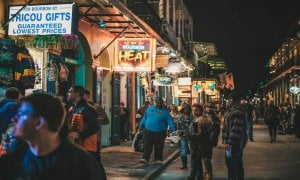Concept of Tourism Multiplier: Tourism being a multi-faceted and interdisciplinary industry has a great potential in generating income and employment (direct and indirect). Tourism, being one of the largest industries for many countries, has a high multiplier effect. The inflow of money from Tourist Generating Region to Tourist Destination Region through various sectors of the economy is very high which contributes to the economic development.

Tourism is on higher trajectory of creation as it not only creates jobs in its own tertiary sector, it also reassures growth in the related primary and secondary sectors of industry. This phenomenon is known as the multiplier effect. In other words, how many times a money spent by a tourist circulates in a particular country’s economy.
You may read Tourism Product Concept
Money spent in a hotel or restaurant helps to create jobs directly in the hotel premises. It also generates jobs indirectly in related or allied industry elsewhere in the economy. For example, the hotel buys food from local farmers or market supplier, who may spend some amount of this money on clothes or other products. Tourists often buy souvenirs from destination this increases demand for local products, which upsurges secondary employment in locally.
Also read about Hospitality
The multiplier effects continue or have ripple effect until the money in due course ‘leaks’ from the economy through imports or other methods.
Multiplier concept is based on Keynesian analysis. It tracks the money spent by the tourists as it filters through the economy. The revenue decreases in a geometric progression at each round as a result of leakages.
Direct tourism expenditures occur when different suppliers of tourism services such as travel agencies, hotels, restaurants etc. provide services. Similarly, indirect expenditures occur due to purchase of handicrafts and availing services during the entire tourism experiences. Again, these expenditures on tourism lead to providing wages and companies can make profit out of tourism business and government may generate revenue through taxes. Causing a wide spread impact on the economy in terms of income, employment and further new investment, this figure also shows how leakages may occur due to high imports causing multiplier weak.
You may read Tourism Product Concept
Tourism Expenditure and Multiplier
Tourism Expenditure can be broadly divided into three types. Namely
- Direct Expenditure,
- Indirect Expenditure
- Induced Expenditure
- Direct Tourism Expenditure consists of expenditures by the tourists on goods and services on hotels, shops, and other tourism related services. It is otherwise known as tourist’s initial spending which creates direct revenue.
- Indirect Tourism Expenditure includes the transaction between businesses caused by direct tourism expenditures. It is otherwise known as the initial process of re-spending i.e., employees’ salary. For example, purchase made by hotels from local suppliers and goods bought by suppliers from the wholesalers.
- Induced Tourism Expenditure consists of increase consumption resulting from increase in income provided by direct tourism expenditure. It is otherwise known as the secondary process For example, the employees of the hotel purchase goods and services otherwise known as re-spending.
- You may read Tourism Product Concept
Types of Multiplier
According to Lickorish and Jenkins, tourist multipliers can be classified into five main broad categories:
- Sales or transaction multiplier: The sales or transaction multiplier measures direct, indirect and induced turnover generated by extra unit of tourism expenditures or additional business turnover.
- Output or production multiplier: The output or production multiplier measures the extra production and accounts an increase in stock levels at hotels, restaurants and shops as a result of increase in commercial or trading activities. The output multipliers are mainly concerned with actual levels or changes in production or output rather than the volume of sales or value.
- Read more on Tourism Product Life Cycle
- Income multiplier: An income multiplier measures the income (receipt) generated by an additional unit of tourist expenditure. The salaries remunerated to overseas residents are not counted, only the proportion of these that has been spent in the area should be included while measuring Income multiplier.
- Employment multipliers: Employment multipliers measure the effects of extra economic activities on employment i.e., the increased number of primary and secondary jobs generated by an extra unit of tourism expenditure. This multiplier can be expressed in namely direct and indirect employment.
- The official or government revenue tourism multiplier: It indicates the net value ie, taxes less subsidies, of government income from tourism.
Use of Multiplier
Multiplier is a tool used to analyze the economic effect of increase in tourism expenditure and its influence on other sectors of the economy. The value of multiplier depends on the particular features of the tourism in the area studied and the characteristics of the local economy.
Also read about Hospitality
The greater the range of activities in the areas the greater would be the chance of higher number of exchange between them. Therefore, the greater is the size of multiplier then the export would be more than import. However, a higher number of imports can reduce the value of multiplier.
Factors Affecting the Size of Tourism Multiplier
The size of the multiplier is affected by different factors. These include:
- The initial volume of tourism expenditure,
- Supply constraints in the area of the economy,
- The size of the area economy,
- Value added in the first round expenditure,
- Tourism industry linkages with the area of economy, and
- Leakages.
You may read Tourism Product Concept
The size of the multipliers depends on four basic factors:
- Size and economic diversity. The overall size of region or country and economic diversity of its economy have a significant role in determining multipliers. Regions with large and diversified economies and producing goods and services of higher order will have high multipliers. As the households and business firms will consume most of the goods and services produced locally.
- Geographic Extent and its Role: It denotes the geographic extent of a region or country and its role within the broader region. Regions of a large geographic extent will have higher multipliers than small areas other things remaining constant, as transportation costs will tend to constrain imports. Regions or countries that serve as central location for the surrounding area or regions will have higher multipliers than those isolated areas.
Read more on Tourism Product Life Cycle
- Nature of the Economic Sectors: The nature and characteristics of the economic sectors under consideration also have substantial impacts. Multipliers vary across all sectors of the economy as the mix of labor and other inputs of every sector have their own propensity to buy goods and services available within the region. As Tourism and allied businesses are labor intensive, it tends to have greater induced rather than indirect effects on sector. When a single multiplier describes a region, mostly it represents an aggregate or average value across many sectors. For more precise and accurate estimates sector-specific multipliers are to be used if possible. A sector-specific multiplier will precisely estimate the secondary effects within a given sector on sales of services and product.
- Year: A multiplier represents the nature of the economy at a given point in time. As any changes over time in response in the economic structure or price changes may change multipliers for a given region. While using regional economic models or multipliers any changes in spending are generally price adjusted to the model year for region. Sales or income multipliers are more directive to general price inflation than employment multipliers and ratios have more chances to change over time.
Limitations of Tourism Multiplier
Insufficient Data: It is observed that due to insufficient data regarding the tourism activities, it is not accurate enough to be used in tourism planning.
Variation in MPC: Variation in marginal propensity to consume leads to measurement in accurate effects on inflation.
Inelasticity of Supply: It is assumed that supply is elastic in all sectors of production. However, developing countries are confronted with a number of problems including
- Lack of availability of resources
- Shortage of foreign currencies
- Inefficiency and insufficient productivity.
Read more on Tourism Product Life Cycle
The Static Feature of Production Function: Multiplier concept can only explain about the past but not forecast the future.
The Time Factor: The study of multiplier does not consider the length of time necessary for the multiplier effect to influence the economy.
Also read Cost-Benefit Analysis





